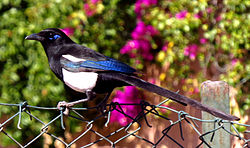| Maghreb magpie | |
|---|---|
 | |
| In Souss-Massa, Morocco | |
 | |
| Marrakech, Morocco | |
| Scientific classification | |
| Kingdom: | Animalia |
| Phylum: | Chordata |
| Class: | Aves |
| Order: | Passeriformes |
| Family: | Corvidae |
| Genus: | Pica |
| Species: | P. mauritanica |
| Binomial name | |
| Pica mauritanica Malherbe, 1845 | |
 | |
| Range of P. mauritanica Resident | |

The Maghreb magpie (Pica mauritanica) is a species of magpie found in North Africa from Morocco east to Tunisia. [1] It can be distinguished from the Eurasian magpie by the patch of blue skin behind its eye, the narrower white belly, the shorter wings, and the longer tail. [2]
A molecular phylogenetic study published in 2018 found that the Maghreb magpie was sister to a clade containing all the other members of the genus Pica . [3]
In recent years, the population of Maghreb magpie in Tunisia has been experiencing a decline. Research has shown that depredation of nestlings by the southern grey shrike ( Lanius meridionalis ), Egyptian cobra ( Naja haje ) and black rats ( Rattus rattus ) were the most important causes of nest failure. The species is subject to brood parasitism by the great spotted cuckoo ( Clamator glandarius ). [4]
